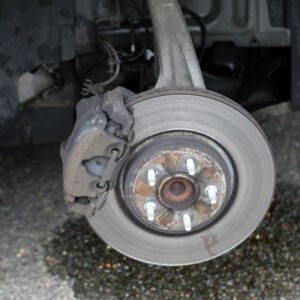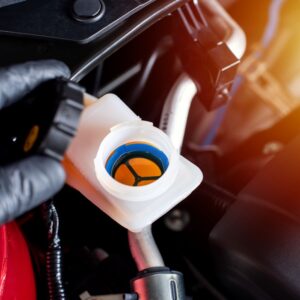Did you know that there’s a proper way to dispose of your brake fluid? Brake fluid is considered hazardous waste, so you can’t just throw it in the trash or pour it down your kitchen sink. To get rid of it, you’ll have to figure out where to dispose of your brake fluid first.
Brake Fluid Disposal At Home
Having trouble finding the time to drive to a nearby waste management facility? Well, the good thing is that you don’t have to. You can dispose of brake fluid in the comfort of your own home by following these steps:
Pour the Brake Fluid Into a Pan of Kitty Litter
Before everything else, you’ll have to collect your old brake fluid from your vehicle. Fill a pan with clean cat litter, and pour your old brake fluid into the pan.
Let the Pan Sit for a Few Days
Once you’ve drained all of your old brake fluid into the pan, you’ll have to place it in a well-ventilated area where it can dry. Be sure not to leave it near your gas stove or any heat source, and keep it out of reach of children or pets.
Throw Away the Cat Litter
After around three to five days, your old brake fluid should have evaporated completely. Empty the used cat litter in a thick plastic bag, and throw it in the trash.
Brake Fluid Disposal at a Waste Management Facility
If you live near a waste management facility, you can get rid of your old brake fluid there too. Most facilities will know exactly how to handle hazardous waste, so you can rest easy knowing they’ll dispose of your brake fluid properly.
Look for Nearby Waste Management Facilities
Before draining your vehicle’s brake fluid, you might want to check out nearby waste disposal centers first. Not all waste management facilities accept brake fluid, so it’s a good idea to make sure they do before you drive all the way there.
Your local government’s website should have information about how to dispose of hazardous waste in your area, so you can start there. If there isn’t enough information on their website, you can also try calling their office first to confirm.
Seal the Brake Fluid in a Proper Container
Once you’ve figured out where to take your old brake fluid, you can now drain it from your vehicle. Place it in a tightly sealed container that’s easy to carry and won’t spill even if it tips over.
Transport the Brake Fluid
It’s finally time to get rid of your brake fluid. Drive down to your local waste disposal center and hand over your old brake fluid.
Some waste disposal centers will charge you a small fee, so be sure to bring some extra cash with you. Instead of a fee, some centers might ask for a donation.

How To Recycle Brake Fluid
You can also recycle your old brake fluid if it hasn’t been contaminated by any toxic solvents. Some recycling centers will accept brake fluid and repurpose it into alternative fuels and cleaning materials.
Look For Nearby Recycling Centers
Driving all the way to a recycling center only to be told that they don’t accept brake fluid is as frustrating as it sounds. To make sure this doesn’t happen to you, check online to see which recycling centers accept brake fluid.
Find out where their drop-off centers are and what days they’re open. You can also try calling them if you have any questions.
Place the Brake Fluid in a Sealed Container
Place your old brake fluid in a clean, leak-proof container. Some recycling centers will have specific instructions about what containers to use, so be sure to follow their instructions too.
Transport the Brake Fluid
All that’s left to do now is to take your old brake fluid and hand it over at your chosen recycling center. Like some waste disposal facilities, some recycling centers will also charge you a small fee, so prepare some cash just in case.
What Is Brake Fluid?
Every time you stop or slow down your vehicle, your braking system releases brake fluid so that you can press down on the brakes with ease. Brake fluid, also known as hydraulic fluid, applies pressure to your front and rear brakes to help stop your vehicle.
Without brake fluid, there won’t be enough pressure to stop your vehicle, making it hard for you to safely stop your vehicle on the road.
Is Brake Fluid Flammable?
The short answer is yes, brake fluid is flammable, just like most of the fluids keeping your vehicle running. However, it isn’t as volatile as some people might think. This means that while brake fluid can certainly catch on fire, it’s unlikely for it to actually be the cause of a fire.
Even if you accidentally expose your brake fluid to a small flame, it shouldn’t be enough to set it on fire. It has to be exposed to intense heat before it actually starts burning.
Why You Need To Dispose of Brake Fluid Properly
Brake fluid might not be highly flammable, but it’s still a toxic substance that you can’t just throw away mindlessly.
Most brake fluids contain diethylene glycol (DEG), a toxic alcohol that’s odorless and colorless. It also tastes sweet, making it appealing to children and animals who won’t know any better and might ingest old brake fluid that hasn’t been properly disposed.
Where To Get Quality Brake Fluid For Your Vehicle
Now that you know how to dispose of brake fluid, you might be wondering where you can conveniently buy new brake fluid. After all, not replacing your brake fluid after a flush is asking for trouble. Having the right brake fluid is essential for fully functional brakes, and thankfully, CarParts.com has an array of brake fluid types in our catalog.
CarParts.com offers a wide selection of brake fluids. Once you find out what type of brake fluid you need, you can order it in just a few quick clicks. Checking out your new brake fluid at CarParts.com is quick, safe, and secure. We also offer fast shipping within the continental US so you can have your new brake fluid delivered in as fast as two business days.
Don’t scramble for new brake fluid at the last minute before a brake fluid drain. Order brake fluid at CarParts.com today.
Any information provided on this Website is for informational purposes only and is not intended to replace consultation with a professional mechanic. The accuracy and timeliness of the information may change from the time of publication.































